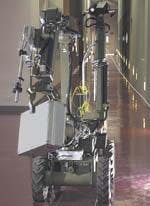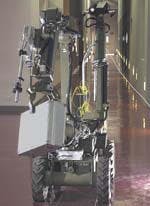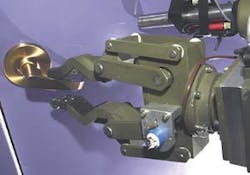By Wilson Dizard III
WASHINGTON — An interagency U.S. government task force working to curb domestic and international terrorism is sponsoring a project at the Department of Energy's Sandia National Laboratory in Albuquerque, N.M., to develop sophisticated robot control systems.
The Technology Support Working Group, which includes representatives from several Pentagon and civilian agencies and is led by the State Department, seeks refinements in the SMART (Sandia Modular Architecture for Robotics and Teleoperation) operating system development tool, which is finding some of its first applications in the field of explosive ordnance disposal.
Phil Bennett, program lead for mobile manipulation at Sandia's Intelligent Systems and Robotics Center, says the robot control software could find battlefield applications as well.
"Right now we are using it to deploy charges to destroy terrorist devices. If you have a briefcase that has an explosive device, you can emplace a specialized charge that will destroy the system without detonating it," Bennett says. "That's done frequently in the field today by civilian law enforcement people."
Bennett adds that robot designers could use the SMART system for detecting land mines or undersea mines. "You might want a vehicle with a manipulator and a mine detector. The manipulator may deploy the mine detector. When it detects the mine, it could put the detector away and dig up the mine, put a charge in place to destroy it, or retrieve it."
Bennett adds that other explosive ordnance applications for the SMART-equipped robots could include removing undetonated explosives that U.S. forces fire into areas that they subsequently overrun.
The SMART software enables robots, such as the Wolverine police robot from Remotec of Oak Ridge, Tenn., to make many of the "how to" decisions in a task, freeing the operator to make the more critical "what to do next" decisions.
In their antiterrorist bomb disposal mission, the SMART-equipped robots can minimize the "time on target" for human bomb technicians, Bennett says.
The system also provides tools for responding to a wide variety of situations, he adds. Sandia engineers have developed 300 software modules using the SMART tool that correspond to different robot capabilities.
"The modules each represent a piece of equipment or other software," Bennett says. "Each module typically communicates with a piece of hardware or software."
1 modular design is not unique, Bennett noted. "What's unique about the approach is the stability of the software control systems when we are finished," he says.
The SMART tool creates an operating system for an integrated robotic system that combines the software modules to control manipulators, sensors, and other components.
Each module is written in C and relies on an algorithm that is based on a "wavelet" function. Wavelets, a form of signal processing function, resemble Fast Fourier Transform functions used for signal processing in other military systems.
The modules run under the QNX real time operating system from QNX Software Systems Inc. of Kanata, Ontario.
"We wanted a real-time operating system to control what happens [on the robot]," Bannett says. "[Microsoft] Windows is not real time." By using a real-time operating system, he says, SMART avoids situations where the operating system halts manipulator motion, for example, to attend to other operating system functions temporarily.
"It's as if you are sitting at your desk and reaching out to grab a pen," Bennett says. "Somebody distracts you and you don't get the pen."
The SMART algorithms enable the integrated robotic system to handle latencies or pauses in robot operation, which arise in nonlinear control systems.
The stability the wavelet-based algorithms affords enables SMART-equipped robots to avoid problems encountered in the development of other autonomous systems, Bennett says.
He gave the example of an autonomous robot programmed to proceed through a door in a house without touching either side. In systems equipped with proximity sensors on either side, each sensor can warn against contact with the doorjamb on its side, and the conflicting signals can cause the robot to bounce between the sides.
However, "a stable system will settle between the sides of the door without extensive tuning of the system," Bennett says.
Because the SMART tool uses a graphical user interface, field personnel can quickly install new modules that provide additional functions for a robot.
The guaranteed stability of SMART-controlled systems eliminates a great deal of engineering time for robot designers, Bennett says. "From the program manager standpoint, there's a significant savings in time and money, as well as access to a wide array of technologies" for sensors, manipulators and other robot equipment, Bennett says.
Program managers can add sensors of various kinds, including infrared, visible light, and proximity sensors, using modules Sandia engineers have already developed. In one configuration, a robot could have a wraparound capacitive proximity sensor to prevent collisions with other objects.
Police applicationsThe Albuquerque, N.M., Police Department has used SMART-equipped robots to practice dealing with mock explosive devices. In that application, the officers used the system to deploy a manipulator arm, aim a "disrupter" used to disable the mock explosive, and stow the arm.Disrupters are specially modified shotguns that fire rounds capable of deactivating a bomb or blowing the cover off a bomb container without detonating its charge. Disrupter equipment by Chris Cherry Engineering Inc. of Albuquerque can also take the form of explosive charges positioned next to a terrorist weapon, says Officer Ken Drummond of the Albuquerque Police Department's bomb disposal team.
"They progressed from deploy and stow to aim, but they will probably never give up firing the disrupter," Bennett says.
In a demonstration in March at the FBI Hazardous Devices School, a SMART-equipped Wolverine robot from Remotec shaved minutes off typical bomb responses, compared to robots controlled by most skilled FBI operators.
So far Sandia experts have developed SMART-equipped robots for 15 separate applications, for a total of about 20 operating units.
Developers at Sandia believe SMART-based mobile robots could clean up chemical spills; patrol perimeters, and respond to attacks; assist in nuclear reactor accident response; lay razor wire or breach barriers for combat engineers; destroy obstacles in urban warfare; and repair satellites in space.
Bennett expects that SMART system users one day will be able to select and download new behaviors or tool modules from a network or off a CD-ROM and insert them in their robots' control systems.





